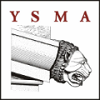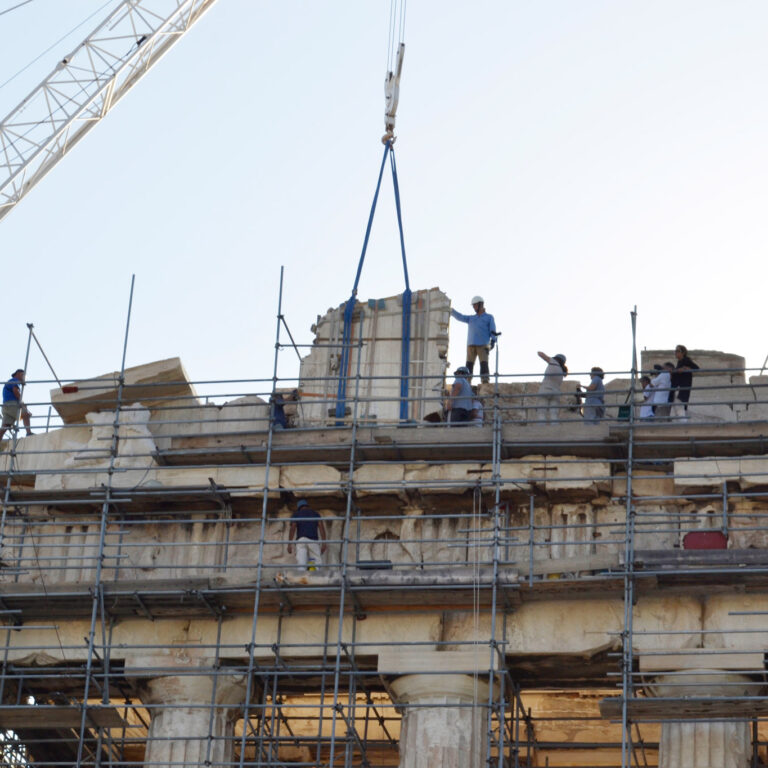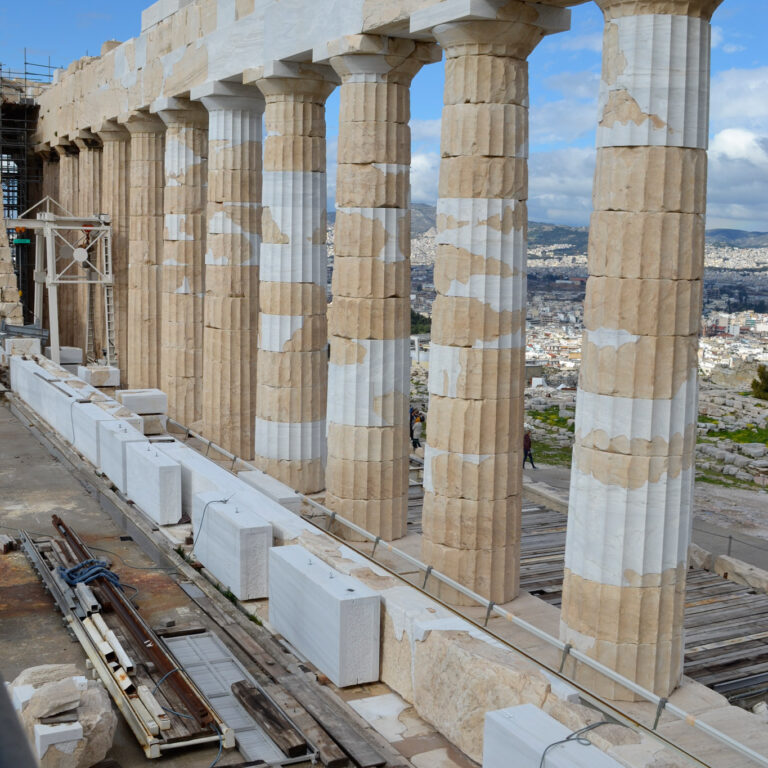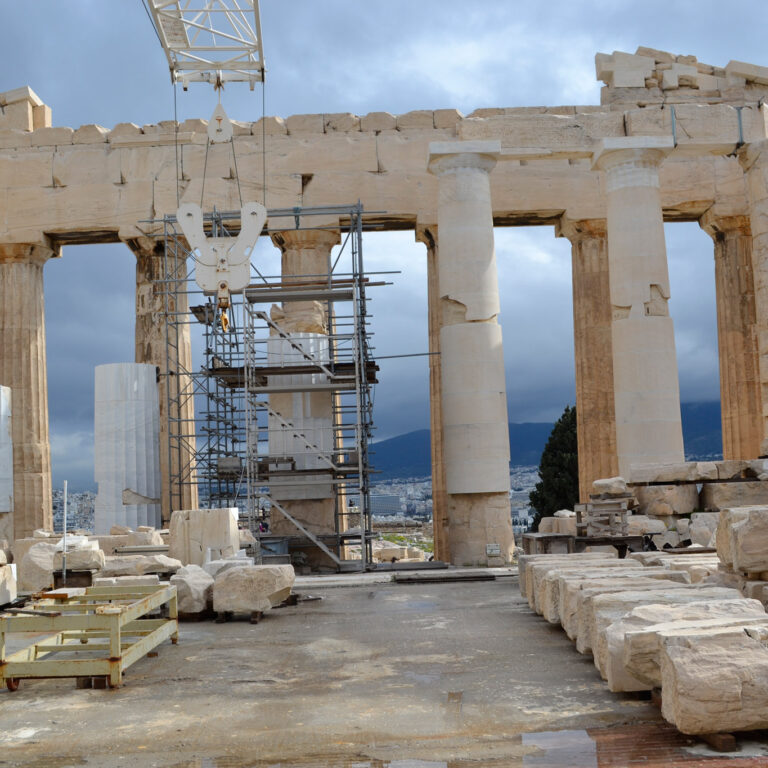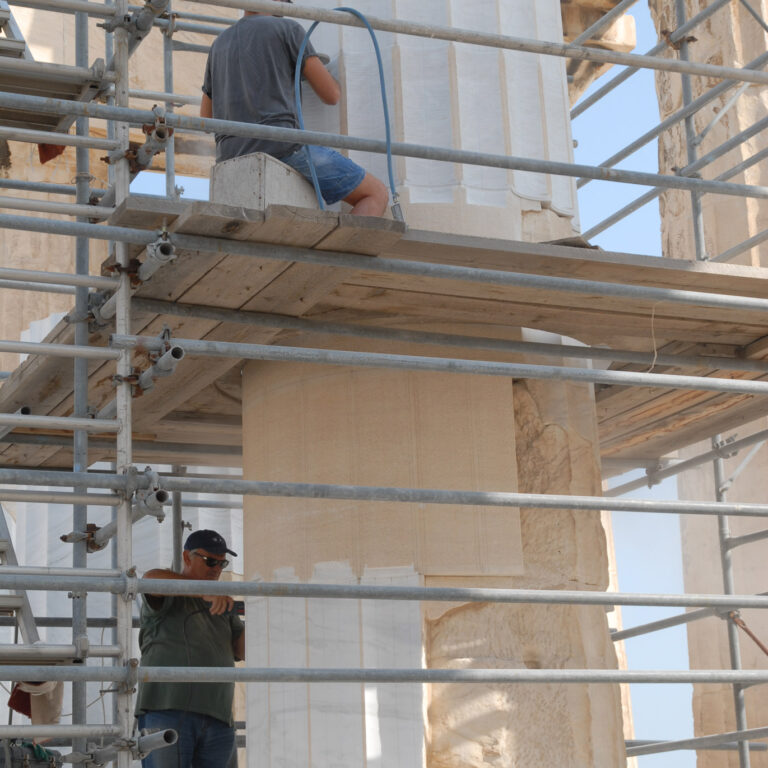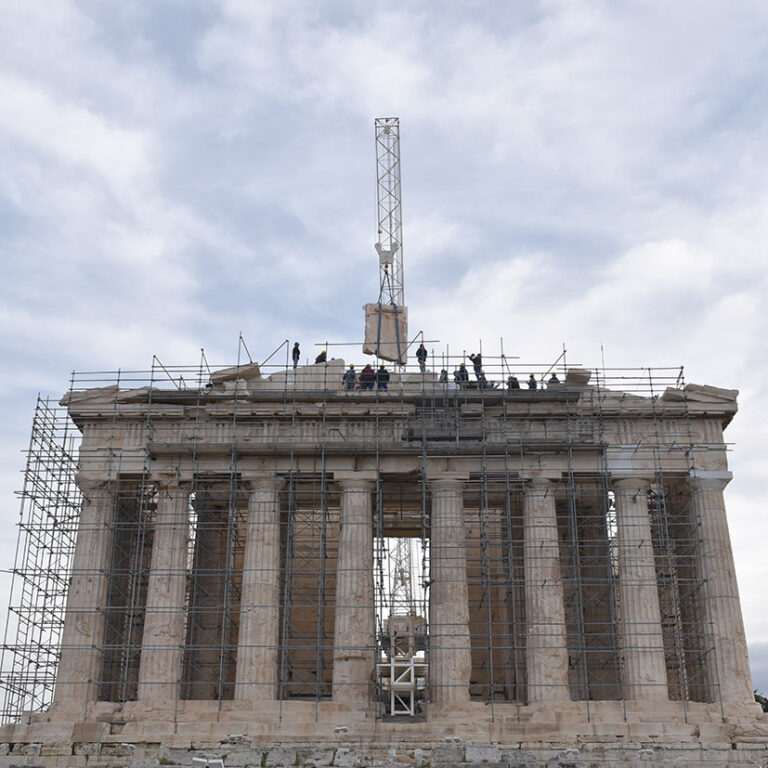
The new period of works funded by NSRF 2014-2020 comprises an extensive intervention programme in the Parthenon concentrating mainly on the pediment of the west side and on the side walls of its cella.
The programme of restoring the west pediment started in June 2017. The work has a rescue character because its goal is to remove the oxidized clamp elements of the Balanos intervention, to conserve and reinforce the architectural members and also to eliminate the distortions and reinforce the seating of the orthostat blocks as it appears to have the most serious static problems. According to the approved studies concerning the restoration of the orthostat of the tympanum (study by V. Manidaki and L. Palaiologos) and the restoration of the backing wall (study by K. Skaris), it is necessary to carry out the following works: the dismantling of 3 middle blocks of the tympanum and the upper layers of the backing wall, their structural restoration and repositioning on the monument. A fourth orthostat and a number of blocks from the backing wall are to be reinforced in situ. For a secure seating and binding of the members few fillings of new marble will be added and used together with specially designed clamp elements made of titanium.
After the dismantling of the upper rows of the backing wall, fractures were found in the blocks of all three lower rows, while the extent of the older interventions in the area became clearer with extensive chiseling off the original blocks and the use of inappropriate materials (Meyer stone glue). After the preparation of the relevant studies by the civil engineers A. Vrouva, I. Durakopoulos and E. Passiou, the structural restoration of the three orthostats of the tympanum was completed, while one more orhtostat was restored on site. At the same time, the structural restoration of the dismantled blocks of the backing wall and other on site blocks was completed. By modifying the program of the western side of the monument, the restoration work was also extended to the horizontal cornice, the upper surface of which was revealed after the removal of the orthostats.
Before the start of the repositioning of the restored architectural members, at the end of 2020, the case of the complete filling of the tympanum of the western pediment of the Parthenon, which had already been approved in 2008, was reviewed by ESMA. The proposal concerned the filling of the tympanum with two additional orthostats, one consisting of three ancient fragments, filled with new marble, and one entirely of new marble. After securing the agreement of the majority of the delegates of the 6th International Meeting on the restoration of the Acropolis monuments, ESMA ratified the old decision of 2008.
At the same time, work continues on the walls of the cella. The sidewalls of the cella were largely destroyed in the explosion of 1687 and partially restored in more recent years, in 1844 and 1928, with the use of blocks placed on the west part of the wall in random positions. During the 90s the restored areas were dismantled, the oxidised iron clamps were removed and alternative possibilities for a new restoration were examined aiming at relocating the blocks in their initial positions (studies by: N.Toganidis-K. Matala and N. Toganidis-K.Parashi).
In the period 2012-2015, structural restoration and repositioning works were undertaken on the toichobate rows, the orthostate, and the first course of the north wall of the cella, in accordance with the updated study by K. Skaris and A. Vrouva. By the end of 2023, the restoration and repositioning of all of the orthostate blocks, as well as the stone blocks of the first and the second course had been completed, while works are being continued with the restoration of the 3rd course. The two lowest rows were fully restored so as to form a solid base for a total of five additional overlying courses that are expected to be restored. This programme’s implementation will contribute to the reinstatement of the structure of the cella walls and the enhancement of the monument’s architecture. In 2022, works were launched on the south wall of the cella, by restoring the toichobate and the orthostate.
The ongoing programmes also involve the carving of flutes in the new column supplements of the Parthenon pronaos. This stage entails the final processing on the surface of drums made of new marble, and requires a high level of expertise and dexterity on behalf of the marble technicians. Currently, the carving of flutes on the new surfaces of the pronaos’ fourth column from the north is being undertaken, while works on the first three columns from the north have already been completed.
Finally, the repositioning of the ceiling beams of the west pteron has been planned. These include 5 restored ancient beams and 10 beams made of new marble in the 1950s. According to the proposal approved by ESMA in 2014 (study by K. Skaris, R. Christodoulopoulou, Z. Konteas and A. Vrouva), the beam grillage will be restored, which will make possible the restoration of all coffers, if this is decided in the future. Following ESMA’s recent decision to amend the original study (2023), restoration works began on the ΔΕΔ3 beam, in line with the study by Z. Konteas. This intervention is expected to create the impression that the monument’s west part is roofed and to partly restore the lighting conditions of the Parthenon’s Ionic frieze.
